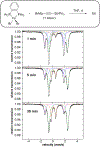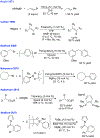Intermediates and Mechanism in Iron-Catalyzed Cross-Coupling
- PMID: 30226380
- PMCID: PMC6217991
- DOI: 10.1021/jacs.8b06893
Intermediates and Mechanism in Iron-Catalyzed Cross-Coupling
Abstract
Iron-catalyzed cross-coupling reactions have attracted significant research interest, as they offer numerous favorable features compared with cross-coupling reactions with precious metal catalysis. While this research has contributed to an empirical understanding of iron-catalyzed cross-coupling, the underlying fundamental mechanisms of reaction and structures of catalytically active species have remained poorly defined. The lack of such detail can be attributed to the difficulties associated with studying such iron-catalyzed reactions, where unstable paramagnetic intermediates abound. Recently, the combined application of physical-inorganic spectroscopic methods, concomitant organic product analysis, and air- and temperature-sensitive inorganic synthesis has yielded the most detailed insight currently available on reactivity and mechanism in iron-catalyzed cross-coupling. This Perspective highlights this approach and the limitations of the contributing techniques as well as some of the key features of the catalytic reactions studied and lessons learned.
Conflict of interest statement
The authors declare no competing financial interest.
Figures











Similar articles
-
Development and Evolution of Mechanistic Understanding in Iron-Catalyzed Cross-Coupling.Acc Chem Res. 2019 Jan 15;52(1):140-150. doi: 10.1021/acs.accounts.8b00519. Epub 2018 Dec 28. Acc Chem Res. 2019. PMID: 30592421 Free PMC article.
-
How low does iron go? Chasing the active species in fe-catalyzed cross-coupling reactions.Acc Chem Res. 2015 May 19;48(5):1485-93. doi: 10.1021/acs.accounts.5b00042. Epub 2015 Apr 28. Acc Chem Res. 2015. PMID: 25916260
-
Iron-Catalyzed Cross-Couplings in the Synthesis of Pharmaceuticals: In Pursuit of Sustainability.Angew Chem Int Ed Engl. 2018 Aug 27;57(35):11116-11128. doi: 10.1002/anie.201800364. Epub 2018 Jul 17. Angew Chem Int Ed Engl. 2018. PMID: 29460380 Review.
-
A Physical-Inorganic Approach for the Elucidation of Active Iron Species and Mechanism in Iron-Catalyzed Cross-Coupling.Isr J Chem. 2017 Dec;57(12):1106-1116. doi: 10.1002/ijch.201700036. Epub 2017 Aug 24. Isr J Chem. 2017. PMID: 29622838 Free PMC article.
-
Iron-Catalyzed C-O Bond Activation: Opportunity for Sustainable Catalysis.ChemSusChem. 2017 Oct 23;10(20):3964-3981. doi: 10.1002/cssc.201701287. Epub 2017 Oct 5. ChemSusChem. 2017. PMID: 28840648 Review.
Cited by
-
Stereoselective Fe-Catalyzed Decoupled Cross-Couplings: Chiral Vinyl Oxazolidinones as Effective Radical Lynchpins for Diastereoselective C(sp2)-C(sp3) Bond Formation.ACS Catal. 2024 Aug 15;14(17):13049-13054. doi: 10.1021/acscatal.4c04568. eCollection 2024 Sep 6. ACS Catal. 2024. PMID: 39263540 Free PMC article.
-
Insight into Radical Initiation, Solvent Effects, and Biphenyl Production in Iron-Bisphosphine Cross-Couplings.ACS Catal. 2023 Jun 22;13(13):8987-8996. doi: 10.1021/acscatal.3c02008. eCollection 2023 Jul 7. ACS Catal. 2023. PMID: 37441237 Free PMC article.
-
General and Practical Route to Diverse 1-(Difluoro)alkyl-3-aryl Bicyclo[1.1.1]pentanes Enabled by an Fe-Catalyzed Multicomponent Radical Cross-Coupling Reaction.ACS Catal. 2022 Oct 7;12(19):11547-11556. doi: 10.1021/acscatal.2c03498. Epub 2022 Sep 8. ACS Catal. 2022. PMID: 39524306 Free PMC article.
-
Effective Alkyl-Alkyl Cross-Coupling with an Iron-Xantphos Catalyst: Mechanistic and Structural Insights.Angew Chem Int Ed Engl. 2025 Jan 2;64(1):e202413566. doi: 10.1002/anie.202413566. Epub 2024 Nov 2. Angew Chem Int Ed Engl. 2025. PMID: 39282992 Free PMC article.
-
The Complex Reactivity of [(salen)Fe]2(μ-O) with HBpin and Its Implications in Catalysis.ACS Catal. 2023 Aug 23;13(17):11841-11850. doi: 10.1021/acscatal.3c02898. eCollection 2023 Sep 1. ACS Catal. 2023. PMID: 37671182 Free PMC article.
References
-
- Kharasch MS; Fields EK J. Am. Chem. Soc 1941, 63, 2316–2320.
-
- Tamura M; Kochi JK J. Am. Chem. Soc 1971, 93, 1487–1489.
-
- Neumann SM; Kochi JK J. Org. Chem 1975, 40, 599–606.
-
- Smith RS; Kochi JK J. Org. Chem 1976, 41, 502–509.
-
- Cahiez G; Avedissian H Synthesis 1998, 1998, 1199–1205.
Publication types
MeSH terms
Substances
Grants and funding
LinkOut - more resources
Full Text Sources
Other Literature Sources
Medical

